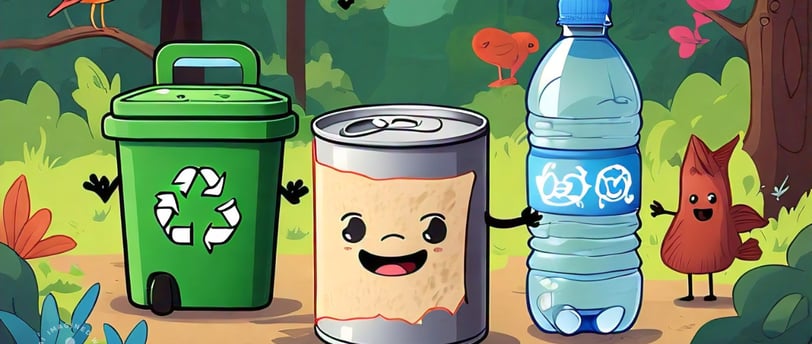Eco-Friendly or Not? Busting Myths of Everyday Items
9/11/20243 min read


With sustainability taking center stage in our lives, the eco-friendly label is popping up everywhere. But what does it really mean? Are those products that claim to be green really better for the environment, or are they just great marketing? Let’s bust some common myths about everyday items and figure out what's truly eco-friendly!
1. Bamboo Toothbrushes: The Green Savior or a Marketing Gimmick?
Myth: Bamboo toothbrushes are the ultimate eco-friendly alternative to plastic brushes.
Truth: While it’s true that bamboo toothbrushes are biodegradable, not all of them are created equal. Many still have nylon bristles, which aren’t compostable. Plus, the production process of bamboo can sometimes lead to deforestation if not sourced sustainably. Look for brands that specify their bamboo is ethically sourced and offer fully compostable options.
2. Reusable Shopping Bags: Always Better?
Myth: Reusable shopping bags are always the better option for the environment.
Truth: It depends! While using reusable bags significantly reduces plastic waste, if you only use them once or twice, the environmental benefits diminish. A study found that cotton tote bags need to be used at least 100 times to be more eco-friendly than single-use plastic bags. So, make sure you’re using those reusable bags over and over to maximize their green impact!
3. Biodegradable Plastics: Totally Guilt-Free?
Myth: Biodegradable plastics will break down in any environment, so they're eco-friendly.
Truth: Biodegradable plastics often require specific conditions—like heat and humidity—to decompose properly, which typically only occurs in industrial composting facilities. If they end up in a landfill or the ocean, they might not break down at all. Always check where and how to dispose of biodegradable plastics correctly to ensure they actually decompose!
4. Organic Cotton: The Ultimate Sustainable Choice
Myth: Organic cotton is always the best choice for the environment.
Truth: While organic cotton is grown without harmful pesticides and synthetic fertilizers, it still requires a lot of water to produce. Additionally, not all organic cotton is created equal. Look for certifications like GOTS (Global Organic Textile Standard) to ensure ethical practices throughout the supply chain.
5. Eco-Friendly Cleaners: Just a Marketing Tool?
Myth: All products labeled as “eco-friendly” are safe for you and the planet.
Truth: Not necessarily! The term “eco-friendly” isn’t regulated, meaning brands can make claims without proof. Some cleaners might still contain harmful chemicals despite being marketed as green. Look for products with certifications, like EPA Safer Choice or Green Seal, to ensure they meet strict environmental standards.
6. Electric Vehicles: Emissions-Free?
Myth: Driving an electric vehicle (EV) means you’re emissions-free.
Truth: While EVs produce zero tailpipe emissions, their environmental impact doesn’t end there. The manufacturing process, particularly for batteries, can produce significant emissions. Additionally, if your electricity comes from fossil fuels, your overall carbon footprint may not be as low as you think. However, EVs generally have a much lower lifetime impact compared to traditional gasoline vehicles, especially as the energy grid becomes greener.
7. Natural Beauty Products: No Chemicals = No Problem?
Myth: If it’s labeled as “natural,” it’s safe and eco-friendly.
Truth: Similar to “eco-friendly,” the term “natural” isn’t strictly regulated. Some natural ingredients can still cause irritation or environmental harm. Always read ingredient lists, and consider brands that provide transparency about sourcing and production practices.
8. Plant-Based Foods: Always a Healthy Choice?
Myth: All plant-based foods are healthy and eco-friendly.
Truth: While plant-based diets can reduce your carbon footprint, not all plant-based products are created equal. Some processed plant-based foods can contain high levels of sugar, salt, or unhealthy fats. Plus, some ingredients (like avocados and almonds) can have a significant water footprint. Focus on whole, minimally processed foods for both health and sustainability.
9. Glass Containers: A Perfect Substitute?
Myth: Glass containers are always more eco-friendly than plastic.
Truth: Glass is recyclable and doesn’t leach chemicals, but it’s heavier and requires more energy to produce and transport. While glass is a great alternative, consider your usage patterns—if you break them frequently, it might offset their environmental benefits. Reusable glass containers can be a fantastic option if used responsibly.
10. Plant Trees and Save the World?
Myth: Planting trees is all we need to do to combat climate change.
Truth: While planting trees is essential, it's not the sole solution to climate change. It's crucial to focus on reducing emissions, protecting existing forests, and maintaining biodiversity. Trees can help, but they should be part of a broader, multi-faceted approach to environmental sustainability.
Conclusion: Making Informed Choices
Navigating the world of eco-friendly products can be tricky, especially with so many myths floating around. The key takeaway? Always do your research and be critical of the claims brands make. Look for certifications, read labels, and consider the full lifecycle of the products you use.
At Hilio, we’re here to help you make informed choices that align with your values while supporting brands that genuinely prioritize sustainability. Together, we can navigate this green journey and make a positive impact on the planet—one choice at a time!
